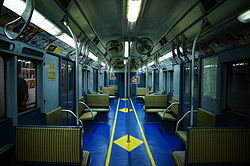This article needs additional citations for verification .(February 2017) |
| R7 | |
|---|---|
 R7A car 1575 at 23rd Street on the Holiday Shopper's Special | |
 Interior of R7A car 1575 | |
| In service | 1938–1977 |
| Manufacturer | American Car and Foundry, Pullman Standard |
| Built at | Chicago, Illinois, USA |
| Family name | R1–9s |
| Constructed |
|
| Entered service | 1938–1939 |
| Scrapped | 1969–1977 |
| Number built | 250
|
| Number preserved | 2 (1 R7, 1 R7A) |
| Number scrapped | 248 (149 R7s, 99 R7As) |
| Successor | R44 and R46 |
| Formation | motorized single units (Half-width operator's cab at each end; conductor controls on exterior) |
| Fleet numbers |
|
| Capacity | 56 (seated) |
| Operators | Independent Subway System NYC Board of Transportation New York City Subway |
| Specifications | |
| Car body construction | Riveted steel |
| Car length | 60 feet 2+1⁄2 inches (18.35 m) over anticlimbers |
| Width | 10 ft (3.05 m) |
| Height | 12 feet 1+5⁄8 inches (3.70 m) |
| Platform height | 3.76 ft (1.15 m) |
| Doors | 8 sets of 45 inch wide side doors per car |
| Maximum speed | 55 mph (89 km/h) |
| Weight | 84,556 lb (38,354 kg) (ACF), 84,750 lb (38,440 kg) (Pullman), #1575: 82,340 lb (37,350 kg) |
| Traction system | Westinghouse 570-D5 or General Electric 714-D1, 714-D2 |
| Power output | 190 hp (142 kW) |
| Electric system(s) | 600 V DC Third rail |
| Current collector(s) | Contact shoe |
| Braking system(s) | WABCO Schedule AMUE with UE-5 universal valve, ME-23 brake stand, and simplex clasp brake rigging. WABCO D-3-F air compressor |
| Coupling system | WABCO H2A |
| Track gauge | 4 ft 8+1⁄2 in (1,435 mm) |
The R7 was a New York City Subway car model built from 1937 to 1938 for the city-operated Independent Subway System by two manufacturers under separate orders, the American Car and Foundry Company and Pullman Standard. They were a continuation of the R6 fleet and closely resemble them, except that the R7/As did not include the “CITY OF NEW YORK” lettering on the middle of the car exterior. [1] A total of 250 cars were built, all arranged as single units. Two versions were ordered: the R7, which consisted of 150 cars, numbered 1400–1549, and the R7A, which consisted of 100 cars, numbered 1550–1649.
Contents
The R7s and R7As were used primarily for increased service in Queens and the opening of the Crosstown Line. They served exclusively on all IND lines for most of their service lives, but were also used on the Eastern Division of the BMT Division's J and L lines during their final years. The R44s and R46s replaced the R7 cars, and they made their final runs in 1977. Two cars, one R7 and one R7A, have been preserved, while the rest of the fleet was scrapped.
